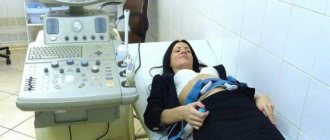The magnetic resonance imaging procedure can provide maximum information for diagnosing severe pathologies. Considering the features of the device, patients are interested: is it possible to do an MRI if there are metal crowns in the mouth? How dangerous is the magnetic field in this situation? There are a number of limitations under which metal parts cause the refusal of important research.
The influence of metal products on diagnostics
The operation of an MRI tomograph is based on the physical property of the electromagnetic field to influence ions that are part of soft tissues. During the magnetic resonance examination procedure, waves of different lengths are emitted, creating high-definition images from several layers. To obtain information, 30–40 minutes are enough, and the study of pathological changes begins from the first minutes of the procedure.
The procedure is painless and does not require special preparation or cleansing from the patient. But to obtain reliable results, the doctor must take into account many factors that can distort the image. These could be any dentures or a pin in a tooth, which on MRI changes the signal conductivity and gives false information.
Alloys become a contraindication to the procedure for a number of reasons:
- When using an old generation device, some types of metal are exposed to the electromagnetic field, heat up and cause unpleasant sensations.
- When pointing the scanner, metal parts undergo a physical reaction and can be attracted or repelled, which affects the overall picture when layers are applied.
At the same time, it is difficult for a radiologist planning to carry out diagnostics to notice neoplasms, hidden inflammations and purulent foci. Therefore, before starting work, he conducts a survey about the presence of any metal structures: rods and spokes in joints, plates that replace skull bones, alloy parts in a heart valve or diabetic pump.
Whether an MRI can be done with metal crowns largely depends on the type of alloy. Just a few years ago, copper, tin, and brass were actively used in dental prosthetics. Patients over 50 years of age still prefer gold crowns, for which the procedure should not be done.
In medicine, all compositions can be divided into several groups depending on susceptibility and interaction with a magnetic field:
- diamagnetic (repel the signal qualitatively);
- paramagnetic agents (may affect the result);
- ferromagnets (strongly react, easily magnetized under a tomograph).
Specialists approach each case individually. If it is necessary to conduct an examination of the lumbar spine and bones of the lower extremities, it is permissible to use standard equipment and high signal strength. Sometimes an MRI of the abdomen and chest can be done using a low-magnetic field scanner. Some ferromagnets eliminate any attempts to obtain images, forcing doctors to select other research methods. It is in the patient’s interests not to hide information so that an expensive procedure will bring the desired results.
MRI diagnostics in the presence of braces
Whether a CT scan can be done with braces depends on the materials used in the melting process. 70% of patients have “budget” systems made of steel fasteners containing various alloys. Modern technologies constantly offer safe formulations that are hypoallergenic and do not contain hazardous substances:
- plastic or metal-plastic;
- ceramics and metal ceramics;
- porcelain;
- titanium;
- nickel;
- sapphire (laboratory production).
While the ban on metal crowns and MRI is understandable, with braces distortion of research results can only be encountered if there are steel parts. They are often present in clasps that secure the structure to the chewing teeth. Therefore, it is recommended to clarify with the dentist the specific composition of the plates, as well as their fastening. If there is a problem, the possibility of temporarily removing the system is discussed if it comes to conducting an MRI of the brain.
A few words about metal-ceramic prosthetics
Metal-ceramic crowns consist of 2 parts.
- Cast frame made of metal. Its thickness is 0.5 cm. It is made from various metal alloys that are slightly susceptible to oxidation under the influence of saliva.
- The outer layer is made of strong and durable material – ceramics. The color usually matches the natural shade of the teeth perfectly.
Such designs look natural. Chewing functions are not impaired.
Diagnostics in the presence of a dental implant
Unlike standard crown prosthetics, during implantation a special rod – a pin – is implanted into the jaw bone. In structure, it resembles a screw, which becomes the basis for the rest of the structure and the crown. It must withstand increased stress when chewing or biting, so only high-quality materials are used for manufacturing: titanium, iron, medical steel, chrome, cobalt, nickel.
If an MRI is required and a post is placed in the tooth, the procedure should be discussed with your dentist. Modern methods allow high-quality examination without possible distortions with a rod size of up to 1 cm. Tomography machines practically do not react to titanium alloys, so the results are distinguished by the required accuracy.
This area of dentistry is actively developing. For implantation, ready-made pins from Korean or American manufacturers are often used. Well-known brands take into account the need to undergo modern examinations, so they are made on the basis of titanium. An attempt to save money and install an inexpensive design often results in an allergic reaction. When performing an MRI, a situation is possible in which such a rod moves and ceases to fix the crown.
Tantalum seams and staples.
Dental implantation using tantalum is a relatively new invention. This material has high biological compatibility. It is practically not rejected by surrounding tissues. Its composition is similar to spongy bone and is ideally embedded in bone tissue.
It is believed that it does not interact with magnetic waves. However, if tantalum staples are still present in the oral cavity, the doctor who performs the MRI must be informed about this before the examination.
We hope that we were able to dispel doubts about whether it is possible to do MRI with crowns and other materials. Almost all of them have been used in dentistry for a long time, are made of modern materials, and are not capable of causing any harm during this procedure. However, in some cases, they can affect the results of the examination, so the doctor conducting it must be aware of the available implants, pins and other structures.
MRI for patients with metal dentures
Depending on the number of damaged teeth, a person is fitted with a removable or fixed denture. Most of them are made by combining several materials:
- metal is used for strength and to create a frame;
- plastic allows you to create streamlined gum shapes;
- metal ceramics perfectly follow the shape.
Clasp bridges and “butterflies” are popular. They are fixed with clasps, so such elements in the oral cavity can be easily removed before starting the device. Is magnetic resonance imaging performed on metal structures? Definitely, this technique can be used to diagnose the abdominal cavity and MRI examination of the pelvic organs.
Understanding the essence of the method - how does it work?
The essence of this diagnostic method is the phenomenon of nuclear magnetic resonance.
The study does not use X-ray radiation, therefore it is one of the safest for the human body. During the examination, the patient is placed on a table, which is subsequently slid into the tomograph. The method works by reacting to magnetic waves of hydrogen atoms located in the tissues of human organs.
The result of the examination is the opportunity to study a series of three-dimensional images of transverse and longitudinal sections of internal organs. The images obtained in this way are highly clear.
A wide range of diseases can be diagnosed using MRI:
- diseases of the musculoskeletal system;
- internal organs;
- brain.
This type of diagnosis makes it possible to identify at an early stage most of the oncological diseases, destructive changes in the brain, destruction of bone tissue, etc. MRI also helps to observe the dynamics of the course of chronic diseases and the growth rate of benign tumors without receiving a dose of radiation. Unlike X-ray methods, magnetic resonance imaging can be used repeatedly without harm to the patient.
Due to the fact that MRI is one of the most informative and safe research methods, it is gaining popularity. This means it raises many additional questions. Let's look at some of them.
Initially, when the method first appeared, it had a more complete name: nuclear magnetic resonance tomography. But the term “nuclear” raised a lot of concerns, so the name was shortened to MRI.
Is it possible to do an MRI with metal-ceramic crowns?
Modern prostheses based on metal-ceramics are increasingly used in dentistry. This type of construction allows you to recreate a lost tooth as realistically as possible and withstands pressure when chewing food. The dentist makes a base that is fixed to the stump and coats it with ceramic coating.
Diagnostics in the presence of metal-ceramic crowns makes it difficult to obtain a high-quality result. The radiologist needs to know the base alloy. If there is even a few percent of cobalt or steel, the resulting image will have erroneous inclusions and will be misleading.
MRI of the brain
The most complex procedure that requires maximum attention is the study of the brain, heart, and coronary vessels. MRI remains practically the only way to diagnose tumors of any size, oncology at the first stage. If you have iron crowns, complications are possible:
- heating the oral tissues above the pin;
- metallic taste;
- absence of entire areas in the photographs.
In such a situation, doctors have to make an important decision: if MRI cannot be replaced by another method, and the disease develops rapidly and is fatal, it is better to remove dental braces and crowns. After treatment, re-implantation can be performed.
Restrictions and prohibitions for MRI
Any design for osteosynthesis made of metal can become an obstacle to diagnosing diseases using a tomograph. Preparation for an MRI always begins with finding out possible contraindications, the list of which includes any iron-based alloys.
If you ignore the ban, you may encounter the following complications:
- burns of the mucous membranes in the oral cavity;
- displacement of the crown or clasp under the influence of a magnetic field;
- structural failure.
The final decision will have to be made by the patient, who must understand all the consequences, become familiar with the contraindications and possible problems. But doctors note that every year the number of people with metal structures decreases: increasingly, dental clients choose high-quality and safe materials that are durable and do not interfere with medical procedures.
Materials for structures
Whether magnetic tomography is possible directly depends on what substance is used to make the devices. Some time ago, dental structures were made only of metal.
The equipment did not affect such products, but the image on the tomograph turned out distorted and blurry.
Currently, dental practice uses metal-ceramic products, which are not a contraindication for the MRI procedure.
Other points are the elements of the devices - plates, screws and pins. They are made from paramagnetic, diamagnetic and ferromagnetic materials - alloys of nickel, cobalt or iron.
Such materials directly affect the magnetic field of the tomograph.
It is also necessary to take into account the shape of the devices and the strength of their fixation, since certain ferromagnets under the influence of a magnetic field become mobile or become very hot.










